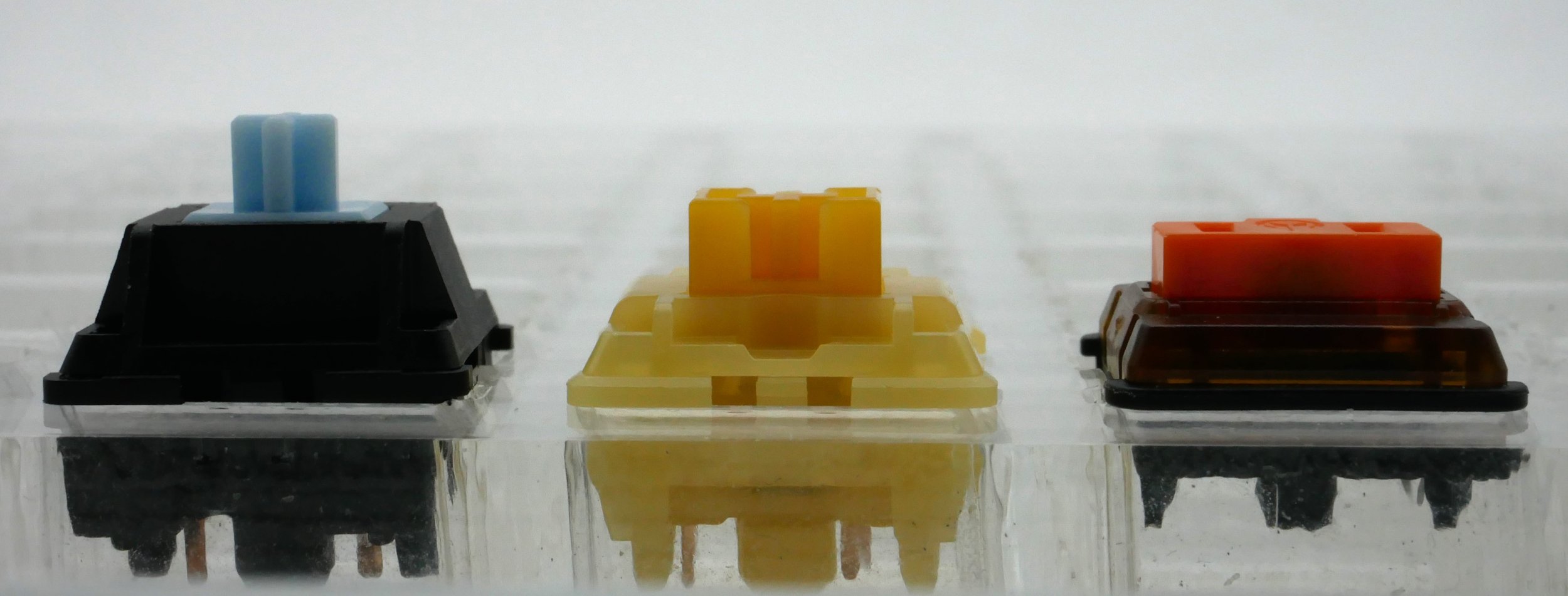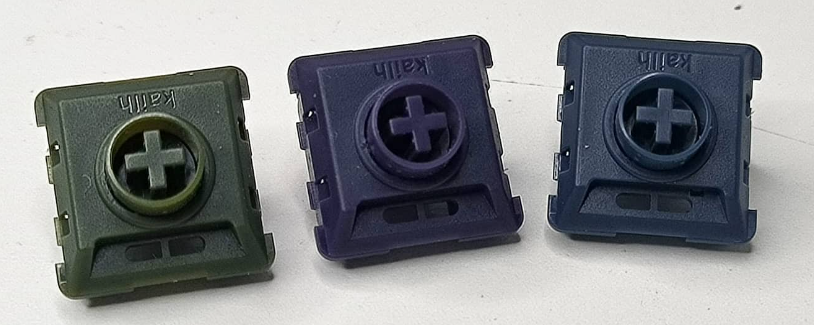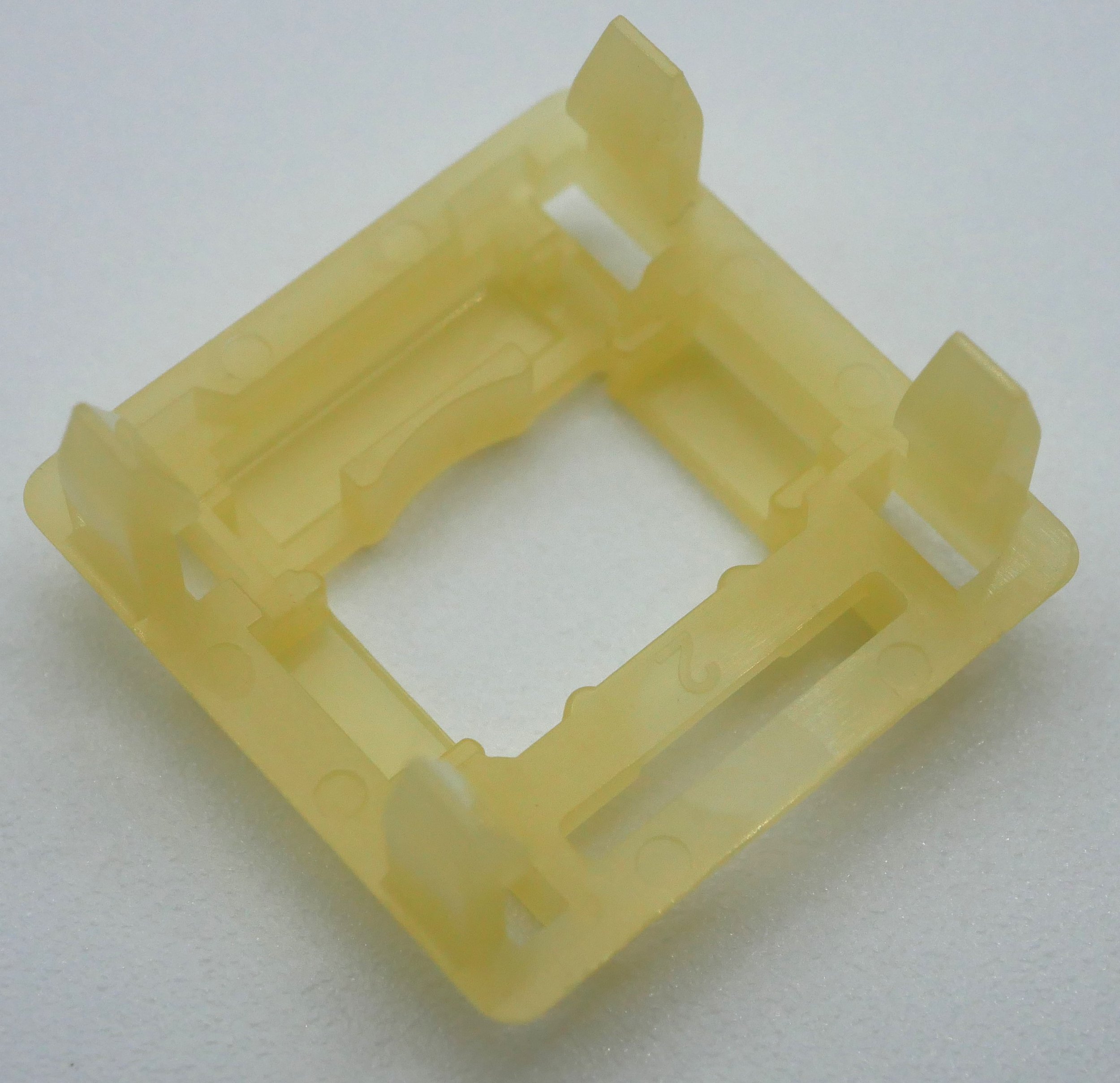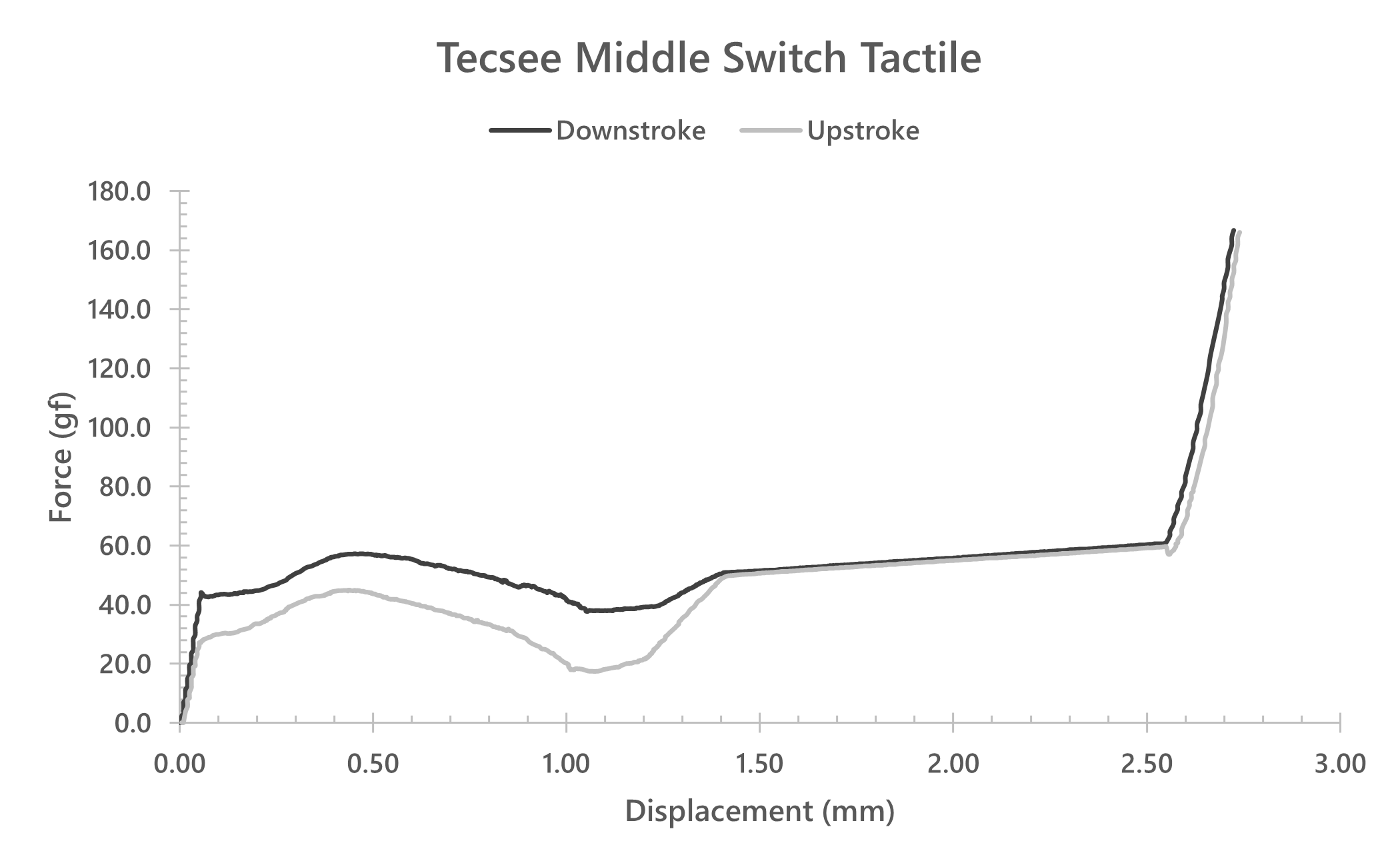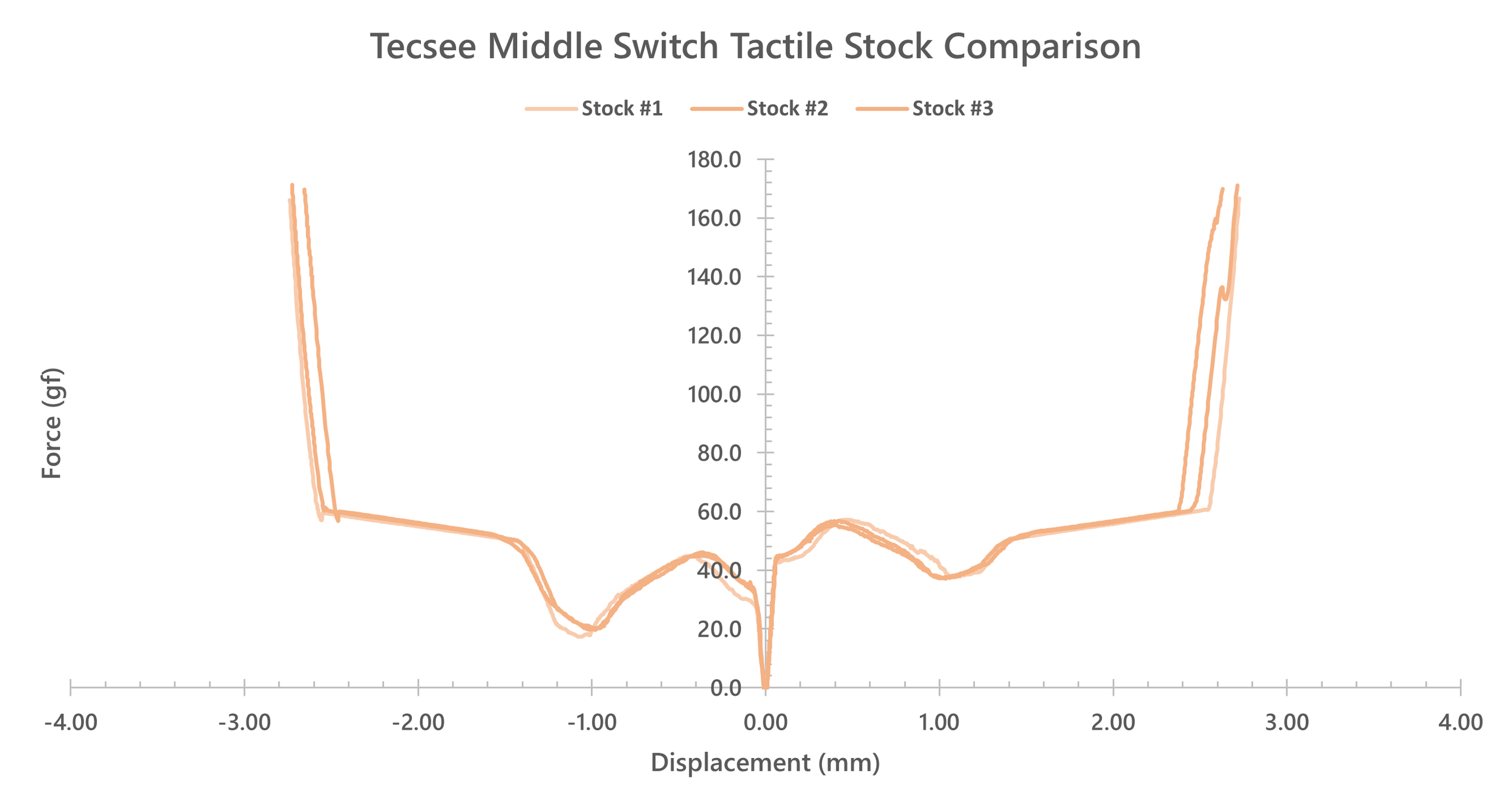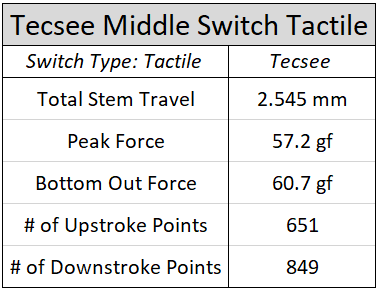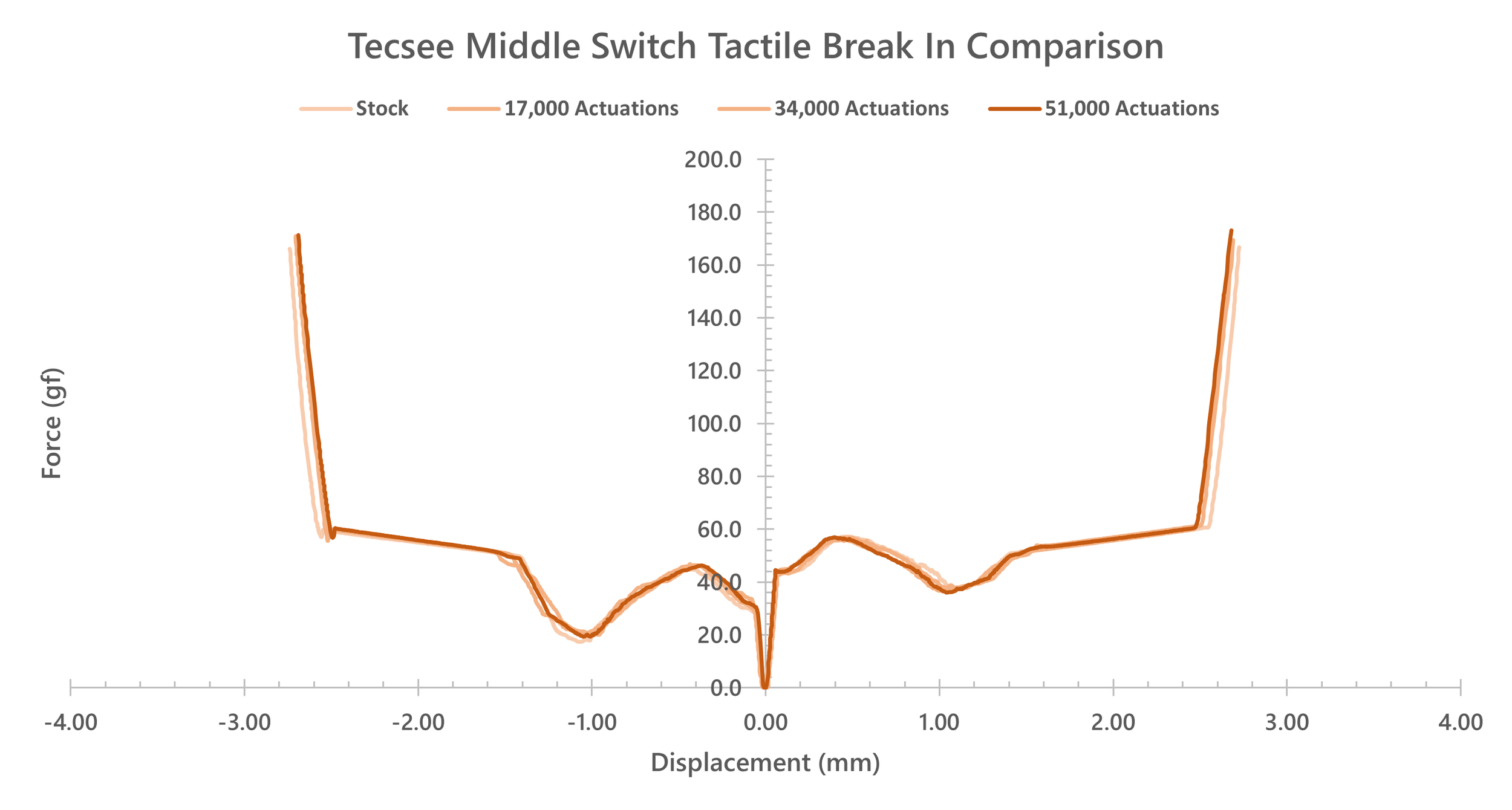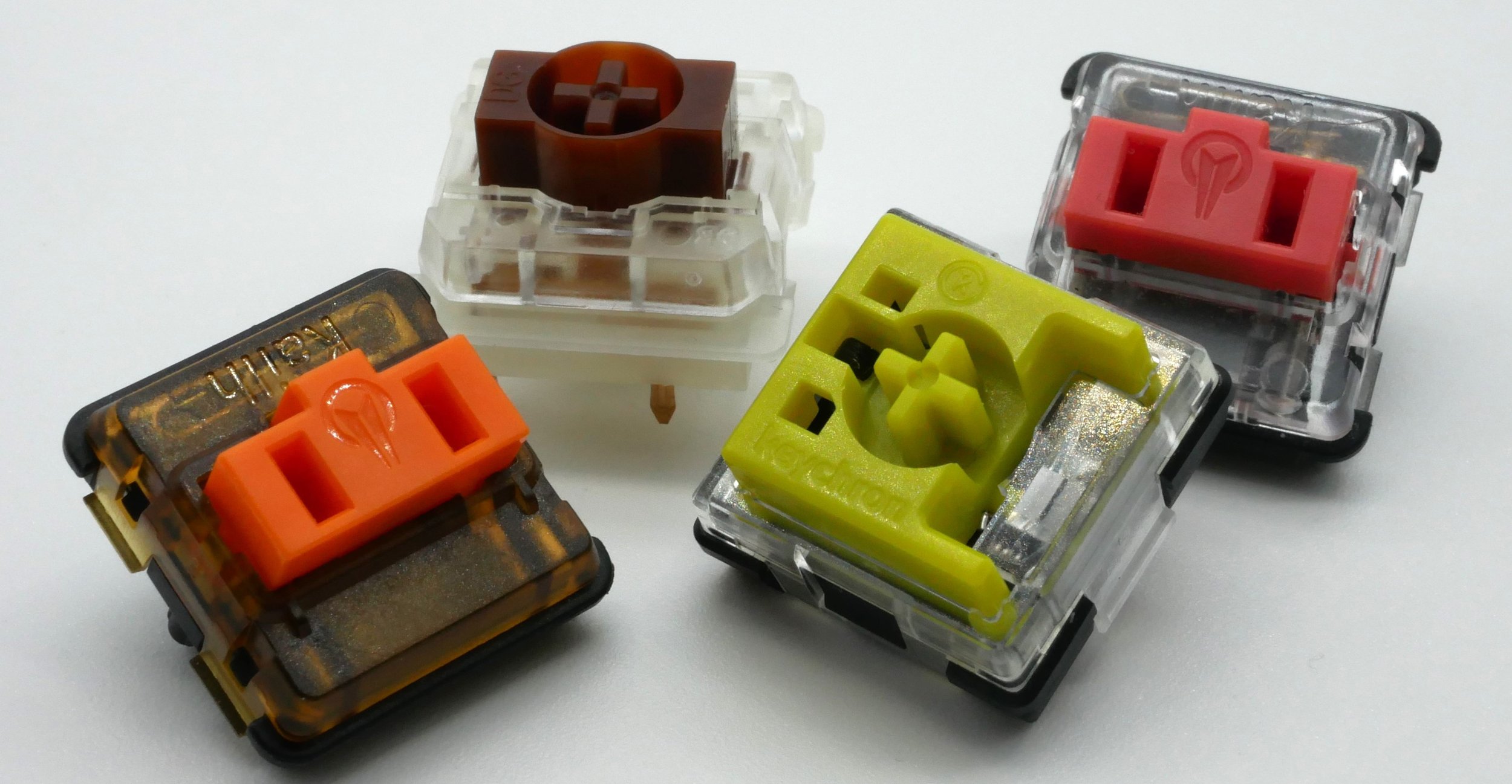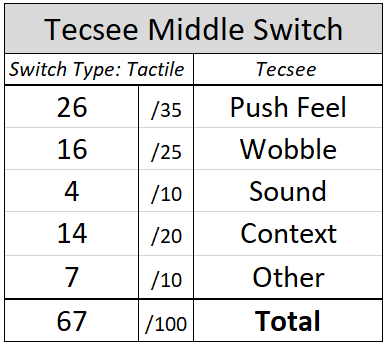Tecsee Middle Switch Review
Figure 1: A TLDR for those requesting such.
Oh look, another long one. For those of you who are not a part of r/mechanicalkeyboards nor are the readers who come to these reviews by way of my posts on that subreddit, you may want to go ahead and skip this opening section as it isn’t for you. A few weeks ago the post announcing my ‘Diamond Avalon Switch Review’ received, to put it lightly, a lot of heated attention on the subreddit. Significantly more attention was paid to that post in particular than almost any other review I’ve had in years if I’m to be honest. Believe me when I say that I read all of the comments, each and every last one of them, and have been thinking hardly over the past week and change regarding some of the demands left there by those readers. After having spent a long-time bouncing ideas around as to how I could change my long winded, rambling style of switch reviews to suit the few among us who took the biggest issue last week, I’m excited to state that I will not be changing a damn thing. This is not Tik-Tok, nor is it CNET. There will be no paragraphs that are half a sentence long. There will be no reorganization of the review structure. And there will be no TLDRs at the top of these reviews either, except for this one, I guess.
Figure 2: I 100% played this scene on a loop in the background as I was writing that introductory paragraph.
Now that all of those hate readers have left after that introductory paragraph to call me mean names somewhere else, I feel compelled to share some of the reasons I do not plan to change the structure of my reviews in a good-faith response to those who did level concerns. The largest reason I do not plan on changing these structures is simple: Consistency. As I have grown as a content creator over the past four years or so of writing switch reviews, I’ve come to accept that change is inevitable. With time I’ve added higher quality photographs, fancier technology, and all new ways of commenting on switches, though I’ve strived extremely hard to not let those affect the overall flow and structure of the reviews week to week. I want any reader who comes onto this website to be able to pull up a dozen different reviews and find them all in the exact same way, with the exact same sections, and telling the exact same tales. Not only does this degree of consistency help readers better navigate all of my reviews in time, but it helps present all switches on the same equal, level playing field that I conduct all of my review testing on. Secondly, and equally as importantly, many people refuse to recognize that this website and these reviews constitute the only documentation that exists for a large number of these switches. Dating all the way back to when I first started writing switch articles, I have always put an emphasis on accuracy, details, and depth of coverage over “readability” and “accessibility.” While I am glad that some of you find these articles entertaining, these are not written for pure entertainment – they are written to provide a full, as unbiased as possible accounting of all of the details both inherent to and surrounding the switch that is being reviewed. I will never carve out details and data from a review to make a comfy seat for those unwilling to use the scroll bar on the side of the page. Finally, I write in this style simply because I enjoy it. This is a voice, tone, and style that I’ve worked for years to craft and since I’m the one that has to sit down and write all of these pages, I’m going to damn well enjoy it as I do.
To those of you who are unsatisfied with that shortened, non-exhaustive rationale as to the continuation of my review structure, I implore you to explore my alternative content. I have a GitHub repository with shortened, one-page scorecards of all of my reviews and hundreds more switches that will likely remain as the shortest and most brief my content will ever be. I do not like the premise of shortening my reviews and cutting out nuance just to make their consumption quicker, and that is the most brevity I can stomach without feeling as if I am lying to you or leaving out part of the truth. If that, or my general attitude regarding TLDRs doesn’t suit you, I would encourage you to be the change you want to see in the community. I started writing switch reviews and detailing the complexities of switches’ histories and inner workings because I did not see that content in the community and so desperately craved that. Nobody is stopping you from making shorter switch reviews if you so choose, and I will be the first and last person to adamantly encourage you to do such – just please don’t rip off my work in the process. If none of the above satisfies you, then damn I’m still wondering why you’re reading this far into the review. I should say the words “tactile” or “linear” just so people can’t complain about it taking that long to find them, as if they were some SEO-sniffing bloodhounds. As for the rest of you, I think you probably get the gist by now, so let’s actually get into the part we all are here for…
Switch Background
There has been absolutely no shortage of aesthetically unique or mechanically interesting switches within the MX-style switch format over the last couple of years. Ranging anywhere from TTC OG Tigers and LICHICX Lucys on the subtle end to the more out-there offerings in Zeal 3-in-1 Clickiez and Diamond Avalons, it almost feels as if I’ve been unable to keep up with all these releases on my normal biweekly review schedule. In fact, I know that I haven’t been able to keep up with these releases as this review is for Tecsee Middle (or Tecsee Medium) switches which have seemingly flown largely under the community’s radar over the past year. First hitting markets and being doled out by Tecsee sales teams as early as mid-August of 2022, Tecsee “Middle” switches sit squarely in the crossroads of ‘aesthetically unique’ and ‘mechanically interesting’ in offering a completely MX-compatible from top to bottom, low(er) profile switch offering. Looking a bit like a normal sized switch that was compacted during an intense round of OSU, these switches effectively spearheaded a wave of new MX-compatible, low-profile offerings that are continuing to be pumped out by manufacturers as we head well into the end of 2023. However, to understand just how strange these “low profile” switches were at the time of their release, and arguably still are now, I’ll go ahead and tour a brief lay of the low-profile switch land and the three-ish categories that they can be separated into:
Ultra-Low Profile Switches
Figure 3: Cherry Ultra Low Profile switches in a marketing display with and without OEM keycaps.
Bordering on the verge of barely being able to be considered true ‘mechanical keyboard switches’ due to their bizarre shapes and functionalities, ultra-low profile switches are few and extremely far in between. The two notable examples in this category, and for that matter the only examples I have in my collection to demonstrate, are Kailh’s ‘X’ switches first introduced in late 2017/early 2018 and Cherry’s new ‘ULP’ switches introduced in mid-2022. While only the Kailh X switches have been sold loosely to the public by way of various vendors over the years, neither of these switches have traditional PCB pin layouts nor keycap mounts, making them almost entirely incompatible with the larger custom keyboard scene as a whole. Even though these switches are incredibly fascinating engineering marvels in and of themselves, the only success that switches as such will likely ever see come in the form of prebuilt keyboards or associated, branded laptops as the community generally is not amenable to generally niche designs.
Figure 4: Kailh's true to reality marketing render of their tactile X Brown switches.
Traditional Low Profile Switches
Figure 5: Various traditional and customized Kailh Choc offerings from throughout the years.
First introduced at the very end of 2016 according to various technical data sheets for their earliest releases, Kailh ‘Choc’ Low Profile switches have grown throughout the years to be implicated as the de facto low profile mechanical keyboard switch. Easily differentiable from other mechanical keyboard switches due to their shortened stature of just over 2.6 mm in total height, this style of switch shares in its general lack of compatibility with the aforementioned ultra-low profile switches. Unlike the Cherry ULP and Kailh X switches, though, Chocs have seen sustained support from Kailh since their debut and in turn have generated a niche, but hard to ignore foothold in the community within the 40s and split ergo-style keyboard designs. (Incredibly unexpectedly, it’s the format with the most inventive and DIY-savvy individuals in the community that just so happens to attract switches with marginal manufacturer support and a unique layout.) In addition to PCBs which have been made in these formats to accommodate Choc switches, several different custom profiles of keycaps (e.g. MCC and MBK) have been created to match the parallel, vertical bar keycap mounting style of the chocs which is similar to that of US electrical wall sockets. Generally priced a touch cheaper than traditional MX-style switches in the $0.30-0.50 range depending on exclusivity of release and design aesthetics, over two dozen different Choc-style low profile switches have been released over the years, including some as recently as late 2022/early 2023.
Figure 6: Kailh Choc measurements directly from spec sheet.
‘New Wave’ Low Profile Switches
Figure 7: 'New Wave' low profile switches from Gateron, Keychron, Outemu, and Tecsee displaying traditional MX-style keycap mounting compatibility.
Starting somewhere in and around the switch innovation boom in 2022, manufacturers and vendors began wising up to the fact that the biggest issue with selling low profile switches is their general lack of compatibility. Wanting to cater to the traditional, MX-style keycap mounts that the vast majority of keycap sets have historically been sold with, manufacturers have since started creating switches with comparable, if not slightly larger side profiles than traditional low profile switches that feature MX-style keycap mounting. Brands including Kailh, Gateron, Cherry, and even (whatever damn manufacturer is used by) Keychron have all introduced some variation of this stunted traditional design that is compatible with most keycaps. While this is a general step in the right direction for community-wide compatibility with low profile switches, many of these brands have also continued to use non-traditional PCB pin outs, leaving the majority of their sales of these switches relegated to prebuilt keyboard offerings with little customizability anywhere below the keycap level. That being said, however, Tecsee’s Middle switches fit well into this new wave of low profile switches in that they not only feature MX-style keycap compatibility at a shortened overall height, but they also feature entirely MX-compatible PCB pin outs as well. Completely disregarding the fact that this still requires stabilizers from Tecsee which are of comparable height to the switches if they were to be used in a full, traditional build, the Middle switches represent a not insignificant step towards broader community adoption of low(er) profile switches.
Figure 8: Relative switch height comparison including normal MX-style (Left), Tecsee Middle Switch (Middle), and Kailh Chocs (Right).
Figure 9: Other unnamed new Kailh low profile offerings as shown on the Instagram of switch collector XCJZ.
As a result of their broader potential community appeal and general custom keyboard kit compatibility, Tecsee Middle switches are currently sold via quite a few vendors both in the west as well as the east that were willing to take a risk on their designs. Priced around $0.48 per switch depending on where they are purchased from, Tecsee Middle, or ‘Tecsee Medium’ switches as they are sometimes referred to, come in a linear and tactile variant with differently colored stems in a banana-ish yellow housing colorway. While their current in stock status across many of these vendors well over a year after their initial release likely signals sustained manufacturing support and multiple production runs by Tecsee, no formal statements have been made as to whether or not Tecsee will sustain this format long term. Additionally, as of the time of writing this review no customized, non-stock offerings in Tecsee’s ‘low profile’ format have been released or even interest checked by vendors or members of the community.
Middle Switch Performance
Note: This review will specifically be covering the tactile variant of the Tecsee Middle switches. Any references made to the linear variants throughout this review will be explicitly stated in the text and thus any ambiguous statements should be assumed to reference the tactile versions.
Appearance
At the highest level, which isn’t all that high, the Tecsee Middle switches come in a translucent, semi-yellowish color similar to that of what Gazzew Boba U4 switches take on with age. Obviously as can be seen above in Figure 8, these switches sit substantially lower than traditional, MX-style switches, though the bulk of the total height is centered in the bottom housings which don’t appear drastically shorter. The nearly pancake-flat top housings, though, are quite a bit shorter than traditional switches, and even the dustproof style stems of the Middle switches don’t protrude out all that far. Tactile variants of the Middle switches have slightly more opaque, cheese-yellow colored stems and the linear variants come in opaque white stems. Aside from differences in their push feeling and stem color, both tactile and linear Middle switches have bottom out forces marketed at 63.5 grams and an identical 2.2 mm full travel distance. Further points of intrigue regarding the design of these switches may be found in the paragraphs below in the part by part breakdown.
Figure 10: Tecsee Middle Switch Tactile switches and their components.
Coming first to the top housings of the Tecsee Middle switches, we are presented with an extremely flattened exterior that is both substantially lower in volume and general angularity as compared to conventional designs. For the lack of space to put features, though, Tecsee really did pack the features in as the housings carry Tecsee’s OEM, stylized logo nameplate as well as full length, thin rectangular through-switch LED/diode slot that has a centered circular indentation for round LED support. They even feature the four gaps just above the bottom housing attachment legs as is common in other switches but otherwise not noted in previous reviews here. One thing worth mentioning regarding the exterior design of these switches is that they initially appeared to have stem holes which were slightly larger and more square upon first inspection. As the ‘Measurements’ section below has borne out, this actually appears to be true with the stem holes in the Tecsee Middle switches being 7.87 mm x 6.34 mm as opposed to a traditional MX-style switch which has an (375 switch) average hole size of 7.64 mm x 6.03 mm. Internally, the housings appear extremely similar to other Tecsee releases and don’t feature anything drastically different in terms of their functionality. The only point of note is the lone, single digit number mold marking on the rim just inside of the rectangular LED/diode slot on the top housings.
Figure 11: Tecsee Middle Switch top housing exterior design showing flat overall profile, Tecsee nameplate, and large, slightly more square stem hole.
Figure 12: Tecsee Middle Switch top housing interior design showing general similarities in structure and mold markings to existing, normal sized Tecsee switches.
Moving next to the stems and springs of the Tecsee Middle switches, I was immediately taken aback by just how hilariously adorable these two components were. All the features commonly associated with stems and springs that I beat to death in this section week in and out just so happen to appear here, but in a mini-me like fashion. Even a thin application of factory lube is present but hard to photograph on the slider rail sides of the Tecsee Middle stems. The stems, in their full 9.78 mm glory, pull up just short of the (375 switch) MX-stem length average 13.04 mm but still feature squared off slide rails, a tiered center pole, and even mold ejector markings in the base of the keycap stem mounting post. For all intents and purposes these are just normal stems which have been shrunk vertically by about 25-30%. The springs also pull up adorably short at about 11.75 mm in total length while still featuring normal and consistent threading throughout their length.
Figure 13: Tecsee Middle Switch Tactile stems and springs showing shortened but expected features including non-tapered slider rails, tiered center poles, and normal spring threading.
Arriving at the bottom housings of the Tecsee Middle switches, we’re greeted with a design and overall size that is much more in line with traditional MX-style housings. As was stated at the onset of this section, the bulk of the size of the Tecsee Middle switches comes in their bottom housings, and a large portion of that is assumed to be due to the leaf structure not being altered in the slightest. Rather than attempting to adopt a Kailh Box-like compact leaf design, Tecsee appears to just have made a smaller overall leaf that doesn’t protrude out from the bottom housings all that much. Otherwise, their internal design is more or less in line with other Tecsee releases, featuring a small south-side spring collar and some friction-reducing vertical ribbing in the slider rail guides. Externally, both tactile and linear Tecsee Middle come only in PCB mount design with normal, common MX-compatible PCB pin outs. In addition to a completely wide open LED/diode slot, the other design feature worth mentioning externally is that of the ‘stacked’ mold marking configuration. Located upside down in the flatter region between the two metal PCB pins, the Middle switches feature a single capital letter directly over top of a single digit number mold marking, something which has not been covered previously in any review on this website.
Figure 14: Tecsee Middle Switch bottom housing interior showing subtle presence of factory lubing, ribbed slider rails, and mold ejector circles in base of the housing in line with traditional bottom housing structures.
Figure 15: Tecsee Middle Switch bottom housing exterior design showing PCB mounting pins and two-tier, single letter and single number mold marking between PCB mounting pins.
Push Feel
For being a miniature version of a normal, MX-style tactile switch, these Tecsee Middle switches still find a way to pack in all of the features that would be expected of their full scale counterparts. First and most importantly, the tactile bumps of the Middles are located right at the very start of their short throw stroke length and pack a bit more of a quick and punchy response to them than their force curve would lead you to believe. There’s virtually no noticeable linear pretravel leading up to the tactile bumps in these switches, either, which gives them that ‘right off the bat’ style of tactility which has become the predominant favorite in the western community in recent years. In addition to the lack of linear pretravel feeling, the Middles have almost no noticeable lag in the linear post-bump region that stretches from 1.4 mm to 2.6 mm of displacement, which constitutes a large portion of this switch’s overall stroke. While some part of this is due to the strength of the tactile bump preceding it, an equally valid argument could be made that it is the factory lube applied to the slider rails of the stems which makes post-bump linear glide possible. Unfortunately, though, this factory lube does not prevent the actual bumps, themselves, from escaping a scratchy, leathery like feeling that happens without an adequate amount of factory lube applied between the point of contact with the stem legs and the leaves. As for the housing collisions, these switches are predominantly underpinned by a deep, larger-than-tactile-bump feeling bottom out that sort of ‘swallows up’ the end of the stroke of these switches. Topping out, on the other hand, is hardly as noticeable due to its similar strength and proximity to the tactile bumps which give these switches their character.
Figure 16: Tecsee Middle Switch Tactile force curve diagram.
With all of that being said about the Tecsee Middle Switch tactiles, though, there is a fair bit of discussion that should be given as to their switch to switch variability. A good majority of the metrics discussed above, including smoothness, bump strength, and especially bottom out strength, all have slightly higher than average switch to switch variation. I wouldn’t say that it is necessarily so much so that these switches need cherry picked or else you’ll have a wildly different key to key feeling, but I could imagine a good few people seriously wanting to make these work in their endgame boards having to do just that. While it is obviously hard to attempt to quantify this variability on any of these metrics, stock switch force curve comparisons at least demonstrate a pretty substantial amount of variability when it comes to bottoming out location and feeling. Looking at the force curve comparison chart below in Figure 17, you can see that the bottoming out of three randomly selected Tecsee Middle Switch tactiles could be anywhere within a broad 0.1 mm range and have odd inflections in force that does not appear to be consistent nor able to be predicted. As I stressed above, this likely won’t make you have to cherry pick these switches out of the bag, but it is still worth mentioning as I very rarely have been able to demonstrate switch-to-switch functional variability as well as I can here.
Figure 17: Tecsee Middle Switch Tactile multiple stock switch force curve comparison.
Sound
The overall sound of the Tecsee Middle switch tactiles is a bit less attractive than their overall push feeling notes above, and in no small part due to that line about leathery scratch introduced at the point of the tactile bump. While these switches are overall on the softer end of the spectrum and don’t carry much volume to their sound, what little sound is present is almost entirely made up of a slightly snappy, leathery raking of the stem legs over the leaves of the switch. Even though there is some subtle undertones to the overall sound profile of these switches which is granted by that gaping, swallowing-of-the-stem bottoming out, it doesn’t do much to mask the scratchy tones from the tactile bumps. There’s really not much else to the sound of these switches though, surprisingly. There’s no input from the linear post-bump region nor the topping out, the latter of which is due to the proximity of such to the tactile bump that is making the majority of said sound. Could the overall tone of these switches and their scratch-forward tones be a bit dampened with that factory lube between the leaves and stems mentioned above? Sure, I don’t see why it wouldn’t. However, I would be a bit more wary in making aftermarket modifications to these switches as opposed to any other standard MX-style switch purely because of the shrunken size of the leaves, which may make it even harder to attempt to lube that point of contact without accidentally gumming it up and ruining the switch entirely.
Wobble
Even with the obviously newer molds required to make these stems and top housings, the Tecsee Middle switches have a fairly standard amount of N/S and E/W stem wobble for a modern, recently made Tecsee switch. Just a hair more present in the N/S than E/W directions, the stem wobble isn’t enough to likely bother most users but may be a problem for some more susceptible to it. As well, I think it is worth mentioning that I don’t think this stem wobble is necessarily a result of the increased dimensions in the stem hole in the top housings either. As compared to standard switch measurements, the stems also seem slightly more proportionally matching to these increased dimensions.
Measurements
If you’re into this level of detail about your switches, you should know that I have a switch measurement sheet that logs all of this data, as well as many other cool features which can be found under the ‘Archive’ tab at the top of this page or by clicking on the card above. Known as the ‘Measurement Sheet’, this sheet typically gets updated weekly and aims to take physical measurements of various switch components to compare mold designs on a brand-by-brand basis as well as provide a rough frankenswitching estimation sheet for combining various stems and top housings.
Figure 19: Numerical details regarding the Tecsee Middle Switch Tactile force curve diagram.
The latest in the content-adjacent work that I’ve picked up, the new ‘Force Curve Repository’ is now hosted on GitHub alongside the Scorecard Repository and contains all force curves that I make both within and outside of reviews. In addition to having these graphs above, I have various other versions of the graphs, raw data, and my processed data all available for each switch to use as you please. Check it out via the ‘Archive’ tab at the top of this page or by clicking any of the force curve cards above.
Break In
Break In Notes
17,000 Actuations
- At 17,000 actuations, the noted leathery scratch tones to the push feeling and sound of the Tecsee Middle switches begin to fade a good bit and be less stand out with respect to overall performance of the switches. That being said, though, they are replaced with a sort of ploppy snappiness instead, which creates more of a ‘rebounding’ type feeling and sound as they are pressed in as opposed to a one-two punch of the tactile bump followed by the bottoming out.
- As is common for most switches that I put through break in testing for reviews, the stem wobble increased a tiny bit in both the N/S and E/W directions in these switches at this stage of break in. It’s not enough to make a drastic difference but nonetheless one worth mentioning.
34,000 Actuations
- After having tested the batch of switches broken out to 34,000 actuations, I’m not altogether convinced that the notes for the 17,000 actuation batch weren’t a result of switch to switch variation. At 34,000 actuations these feel and sound simply like a smoother, less scratchier version of their stock form. It almost makes it seem like the 17,000 actuation set was a sort of ‘moody teenager phase’ for their breaking in feeling.
- There was no general increase in stem wobble in either N/S or E/W directions in the set of Tecsee Middles broken in to 34,000 actuations.
51,000 Actuations
- If we go ahead and take the ‘moody teenager phase’ comment from the last round of actuations to heart, then these switches basically stopped aging after moving beyond the cringe. These switches do not appear to have improved substantially, if at all, past 34,000 actuations. I may be able to find one or two more switches which are smoother than the 34,000 actuation lot among these, but as has been stated several times over, I’m more than willing to chalk this up to switch to switch variability given that it very much is present in the Tecsee Middles.
Figure 21: Comparative force curve diagram showing no distinctive trend in change of the Tecsee Middle Switch Tactile force curve diagrams throughout the break in progress.
Comparison Notes to Other Notable Tactile Switches
Note – These are not aimed at being comprehensive comparisons between all factors of these switches as this would simply be too long for this writeup. These are little notes of interest I generated when comparing these switches to the Tecsee Middle switches side by side.
Figure 22: Switches for comparison. (L-R, Top-Bot: Gateron Root Beer Float, Neapolitan Ice Cream, Lubed Invokeys Blueberry Chiffon, MODE Tomorrow, Betty, and Kailh Box V2 Brown)
Gateron Root Beer Float
- As can be interpreted from the comparison force curve below, the tactile bump in the Gateron Root Beer Floats feels significantly larger and longer lasting than the comparatively short, rapid tactile burst of the Tecsee Middle switches. This is even in spite of the fact that they share nearly similar peak tactile forces.
- The Gateron Root Beer Floats are a touch better than the Tecsee Middle Switch tactiles when it comes to both N/S and E/W direction stem wobble.
- In a stock, head to head comparison, the Tecsee Middle Switches are noticeably more scratchy through their tactile bump than that of the Gateron Root Beer Floats. That being said, though, the Middle Switches broken in to 51,000 actuations began to take on a similar degree of scratch as the stock Root Beer Floats.
Neapolitan Ice Cream
- Even though the comparative force curves for this switch and the Gateron Root Beer Float above it look similar, the Neapolitan Ice Creams have a significantly stronger and more punchy feeling tactile bump than the Tecsee Middle switches. I’m assuming this is a function of the elongated, multi-stage springs of the Neapolitan Ice Cream switches.
- The Tecsee Middle Switch tactiles are a bit better than the Neapolitan Ice Cream switches when it comes to the N/S and especially the E/W direction stem wobble.
- The scratch present in stock Neapolitan Ice Cream switches is much more small grain and plastic-on-plastic like in feeling as opposed to the more textured, velvety scratch of the Tecsee Middle switches.
Lubed Invokeys Blueberry Chiffon
- Of all of the switches on this main comparison list, the Invokeys Blueberry Chiffons have the most similar tactile bump to the Tecsee Middle switches. Even though it is located a bit deeper into the downstroke than the Middle switches, the general strength and size of the bump feels surprisingly similar.
- In terms of their out of the box smoothness, though, there’s no doubt that the Invokeys Blueberry Chiffons are significantly more smooth than the Tecsee Middle switches. Honestly, its hardly even a fair comparison.
- Additionally, the strong design execution of the Blueberry Chiffons has led them to having much less N/S and E/W direction stem wobble than both the Tecsee Middle switches and most switches in general, for that matter.
MODE Tomorrow
- Even though the peak tactile force of the MODE Tomorrow switches is a bit larger than that of the Tecsee Middle switches, the Tomorrows feel a bit more softer and as if their tactile bump is more spread out. By comparison, the Tecsee Middle switches feel short, punchy, and easily more recognizable as ‘tactile’.
- The MODE Tomorrow switches have quite a bit less stem wobble than the Tecsee Middle switches in both their N/S and E/W directions.
- As for their factory smoothness, the Tomorrows have a much more consistent and generous application of factory lube which not only leads to their tactile bumps feeling smoother than the Middle switches, but also their linear post-bump regions.
Betty
- Much like with the Neapolitan Ice Cream switch comparison above, the Betty switches feel significantly stronger in their tactile bump and punch with a lot more force than the Tecsee Middle switches.
- As a result of the more recent molds that were created for the Betty switches by Haimu, they have less stem wobble in both directions than the Tecsee Middle switches.
- The Betty switches also have a much better application of factory lube and feel smooth enough that one would hardly question if scratch was an issue with switches at all if they had just tried these and these alone. The same cannot be said for the leathery tactile bump scratch that is present in the Tecsee Middle switches.
Kailh Box V2 Brown
- Surprisingly, the Tecsee Middle switches feel as if they have a slightly more noticeable tactile bump than the Kailh Box V2 Browns, regardless of what the force curve comparison may lead you to believe. I suspect that this may be due to the slightly more compacted distance over which the tactile bump occurs in the Middles, making them feel a bit more sudden than the Box V2 Browns.
- In terms of stem wobble, the Kailh Box V2 Browns just edge out the Tecsee Middle switches in both directions. This sort of lower wobble in Box switches is not exactly a universal trait, either, making these seems as if they have generally more improve molds than previous iterations.
- Of all of the switches on this list, these two switches have the most similar overall volume. That being said, though, there is a much more overwhelming amount of scratch sound in the Kailh Box V2 Browns than the Tecsee Middle switches, which have their scratch noise at their tactile bumps.
Bonus Round
Life is short but probably not as short as this switch for most of us. May as well live a little and add some more comparisons since I don’t discuss low profile switches much in reviews.
Figure 29: Bonus round switches from comparison. (L-R: Kailh Choc Sunset, Gateron Low Profile Brown 2.0, Keychron Low Profile Banana, and Kailh Choc Low Profile Burnt Orange)
Kailh Choc Sunset
- The same notes that have been made for two other bonus round switch comparisons with respect to their rattly, almost cheaply constructed mechanism sound and feeling can be directly applied to the Kailh Choc Sunset switches. These just simply feel much more chaotic, borderline clicky in their execution than the cleanly tactile Tecsee Middle switches.
- Of all of the switches on this bonus comparison list, the Choc Sunset are not only the loudest and highest pitched, but carry the most amount of scratch in their general sound.
- While it is admittedly a bit difficult to attempt to compare stem wobble with Choc switches due to their significantly reduced stem height above the top housings, there is no doubt that the Choc Sunsets have a lot more N/S and E/W direction stem wobble than the Tecsee Middle switches.
Gateron Low Profile Brown 2.0
- Much like with the other low profile switches on this comparison list, the tactile bump in the Tecsee Middle switches feels noticeably more distinct and center stage than the Gateron Low Profile Brown 2.0s.
- Additionally, the Gateron Low Profile Brown 2.0s also have a bit of rattly, plasticky pieces in their mechanism that make noise and provide some minor push feeling feedback that is otherwise just completely absent from the Tecsee Middle switches.
- In terms of overall volume, the Middle switches are noticeably more quiet and lower pitched than the Gateron Low Profile Brown 2.0s.
Keychron Low Profile Banana
- While the Keychron Low Profile Banana switches do stray away a bit from the rattly, chaotic sounds that have highlighted all of the other low profile switches on this bonus comparison list, they do sound distinctively more so like a clicky switch than the Tecsee Middle switches. They sound so much like a clicky, in fact, that I had to look it up to verify that I somehow didn’t catalogue them incorrectly.
- Regardless of what the force curve comparison below may lead you to believe, these switches feel quite different from each other in regard to their tactile bumps. The Tecsee Middle switches almost feel as if they are a slightly more strong and forceful ‘older brother’ to the Keychron Low Profile Banana switches’ tactile bumps.
Kailh Choc Low Profile Burnt Orange
- Even though the Choc Low Profile Burnt Orange switches have a technically longer travel distance, the Tecsee Middle switches feel as if they have a noticeably longer overall stroke length. I’m not entirely sure how this is the case, but it is noticeable enough that I can detect it without actively seeing which switch I’m pressing.
- In terms of their overall design feeling, the Tecsee Middle switches feel much more composed, singular, and well-designed than the Choc Burnt Oranges. There is a certain rattly, somewhat click-jacket like vibe to the bottoming out of the Choc Burnt Orange switches that is altogether absent from the Tecsee Middle switches.
- In addition to the added rattly sound which accompanies the feeling in that previous comment, the Kailh Choc Low Profile Burnt Orange switches sound noticeably more loud than the Tecsee Middle switches, and especially so at higher actuation speeds.
Scores and Statistics
Note – These scores are not necessarily completely indicative of the nuanced review above. If you’ve skipped straight to this section, I can only recommend that you at least glance at the other sections above in order to get a stronger idea of my opinion about these switches.
Push Feel
Packing a start-of-downstroke tactile bump, these short throw switches start out with a small but punchy tactile bump that melts into a smooth linear post bump region capped off with a deep void of a bottom out. While the bottom out and linear region after the bump and smooth and subtle enough to be of note, these benefits are more or less lost behind a leathery and scratchy feeling tactile bump due to a lack of adequate factory lube on the contact point between the stem legs and leaves. Additional batch-wide variability on these points do them no favors as well.
Wobble
Even with entirely redesigned molds to accommodate the shortened top housings and compacted stem structure in these medium height switches, there is still a bit of N/S and E/W direction stem wobble that could be bothersome to some users.
Sound
Given that the bottom out of the Tecsee Middle tactiles hardly provides any sound to them at all, the overall quiet and subdued sound of these switches is largely dominated by the aforementioned bump scratch in the ‘Push Feel’ section above. This doesn’t appear to necessarily get any better in that switch to switch variability either, appearing slightly worse than average in a not insignificant amount of switches.
Context
Coming at the start of the ‘new wave’ of low profile switches in 2022, the Tecsee Middle have had surprising staying power over the first year and change of their existence. While not discussed all that much by the community, decent pricing with large vendor support and implied manufacturer support means these could stay around for quite some time more...
Other
While unlikely to be the single switch which busts open the low profile switch category, these are incredibly interestingly designed and executed pieces of switch history to remember.
Statistics
If you are looking at this statistics section for the first time and wondering where the hell are the other 260 switches that I’ve ranked are, or what ‘hard’ versus ‘soft’ ranks refer to specifically, I’d encourage you to head on over to my GitHub linked in the table above or at the links in the top right hand of this website to check out my database of scorecards as well as the ‘Composite Score Sheet’ which has a full listing of the rankings for each and every switch I’ve ranked thus far.
Final Conclusions
At the end of it all, I must say that I am simultaneously impressed with and disappointed by the execution of the Tecsee Middle switches. On the impressed end of things, one which is more context-inclusive and wholistic regarding the current state of mechanical keyboard switches, I can’t help but recognize how unique these switches are amidst their peers. As brands and manufacturers have continued to try and push low profile switch formats with low custom community compatibility, we have yet to see any real champion take on the throne that has been capped by Kailh’s Choc style. Rather than trying to push yet another standard into the format, Tecsee has clearly attempted to circumnavigate their way to the top by meeting demands of low profile switches while still keeping with the widely accepted MX-style pin outs and keycap mounts that the custom community has adopted as the standard for well over a decade now. Doing so with brand new sets of molds and a decently innovative shift in the size and structuring of internal components, it was a bit initially surprising that these haven’t gotten more recognition from the community at large in the past year of their existence. That being said, though, my disappointment stems from the fact that that lack of recognition and celebration is completely understandable after having tested out these switches in hand. While unique in their shape and execution, the Tecsee Middle switches are still lacking some single switch and batch-wide quality control to really home in on what makes any keyboard switch great, let alone ones which could fill a niche design market. If Tecsee could improve upon their factory lubrication and switch to switch variability, I could very well see this style being among the more dominant choices amidst a growing field of low profile switches in the years to come. However these Tecsee Middle switches and/or the low(er) switch profile that they provide pan out, though, know well that it will have to come by way of the action or inaction of Tecsee themselves. The opportunity is there.
Sponsors/Affiliates
Mechbox UK
- A wonderful UK based operation which sells singles to switches that I’ve used above in my comparisons for collectors and the curious alike. Matt has gone out of his way to help me build out big parts of my collection, and buying something using this link supports him as well as my content!
KeebCats UK
- A switch peripheral company based out of the UK which sells everything switch adjacent you could ask for, they’ve been a huge help recently with my film and lube supply for personal builds, and they want to extend that help to you too. Use code ‘GOAT’ for 10% off your order when you check them out!
proto[Typist] Keyboards
- An all-things keyboard vendor based out of the UK, proto[Typist] is a regular stocker of everything from switches to the latest keyboard and keycap groupbuys. While I’ve bought things from the many times in the past, they also are a sponsor of my work and allow me to get some of the great switches I write about!
Divinikey
- Not only do they stock just about everything related to keyboards and switches, but they’re super friendly and ship out pretty quick too. Divinikey has been a huge help to me and my builds over the last year or two of doing reviews and they’ll definitely hook you up. Use code ‘GOAT’ for 5% off your order when you check them out!
ZealPC
- Do they really need any introduction? Zeal and crew kicked off the custom switch scene many years ago with their iconic Zealios switches and the story of switches today couldn’t be told without them. Use code ‘GOAT’ (or click the link above) for 5% off your order when you check them out!
MechMods UK
- A rising vendor based in the UK, Ryan and crew have been a pleasure to work with and have nearly everything you’d need to build your first or fourteenth keyboard. Go build your latest or greatest one right now with them by using code ‘GOAT’ at checkout for a 5% discount!
Dangkeebs
- A longtime supporter of the website and the collection, Dangkeebs has quite possibly the widest variety of switches of any vendor out there. Not only is their switch selection large, but it rotates and is constantly adding new stuff too. You’re going to need 5% off your order with my affiliate to save off the cost of all those switches!
SwitchOddities
- The brainchild of one my most adventurous proxies, SwitchOddities is a place where you can try out all the fancy, strange, and eastern-exclusive switches that I flex on my maildays with. Follow my affiliate code and use code ‘GOAT’ at checkout to save 5% on some of the most interesting switches you’ll ever try!
Cannonkeys
- Does anybody not know of Cannonkeys at this point? One of the largest vendors in North America with keyboards, switches, keycaps, and literally everything you could ever want for a keyboard always in stock and with an incredibly dedicated and loving crew. Follow my affiliate link above in their name to support both them and I when you buy yourself some switches!
Kinetic Labs
- One of the most well-rounded keyboard vendors out there, Christian and crew have been supporters of all my switch and switch-adjacent needs for some years now. I’m honored to have them as an affiliate and think you should check them out using my affiliate link above to support both them and I when you check out their awesome products!
Keebhut
- Want to try out some switch brands that fly under most vendor’s radars? Keebhut is always seeking out that next latest and greatest and has been super helpful in hooking me up with new brands over the past year. They are all about sharing that love as well, and want to give you 5% off your next order with them when you use code ‘GOAT’ at checkout!







